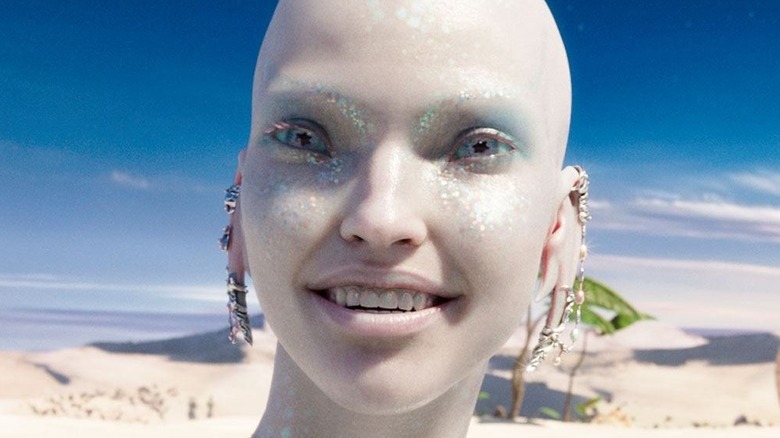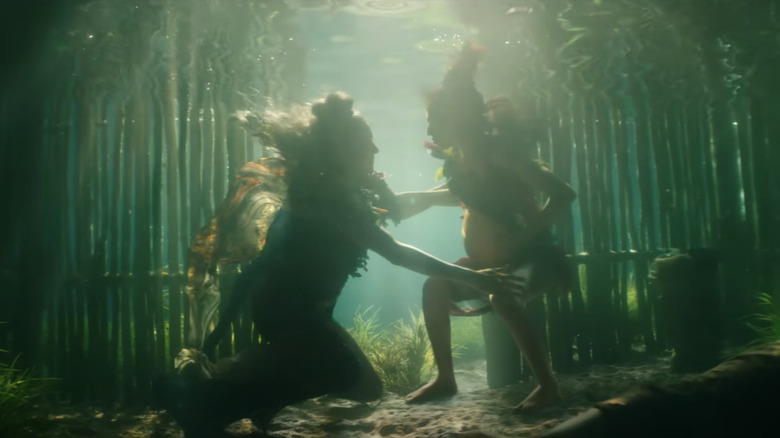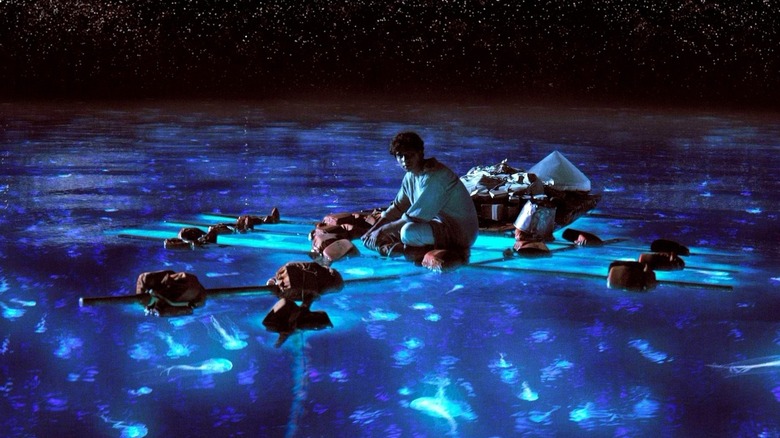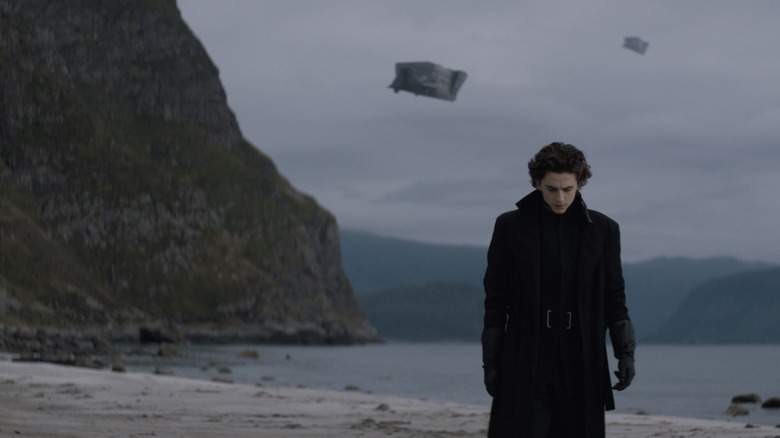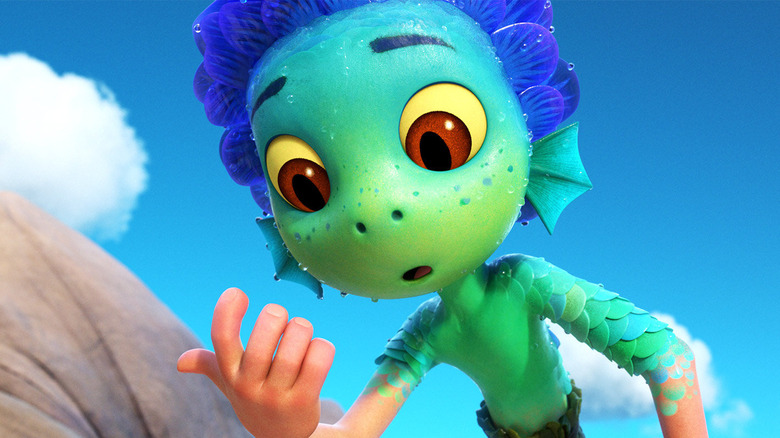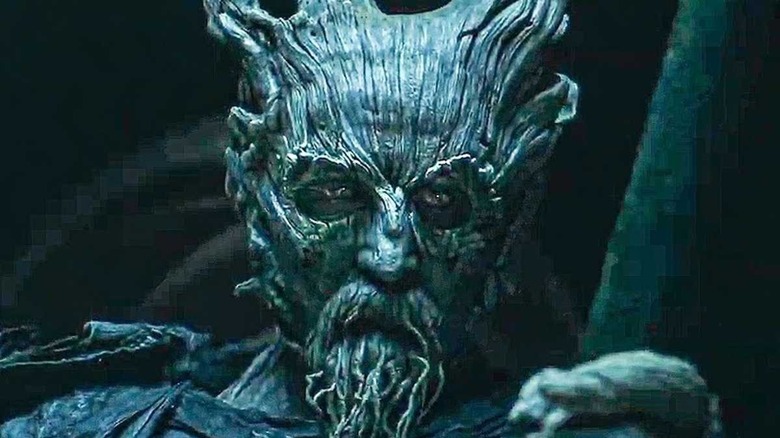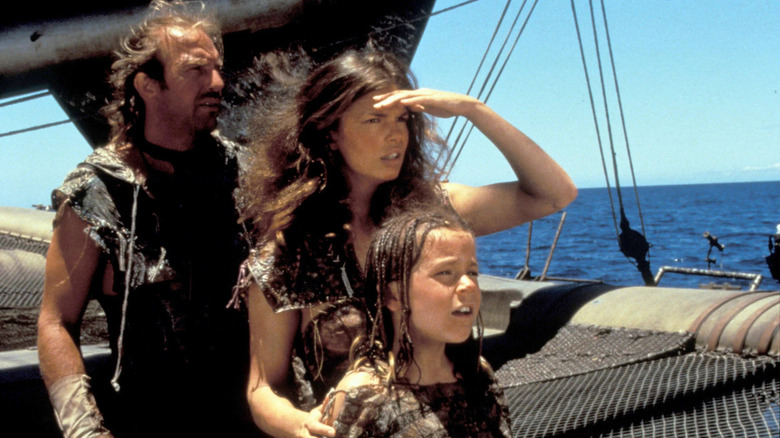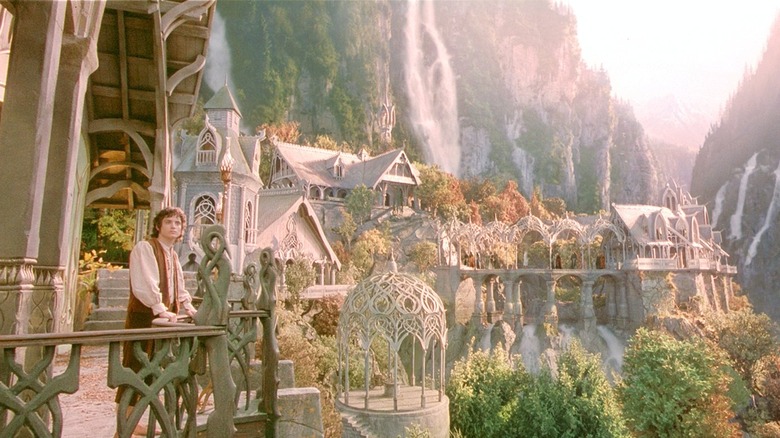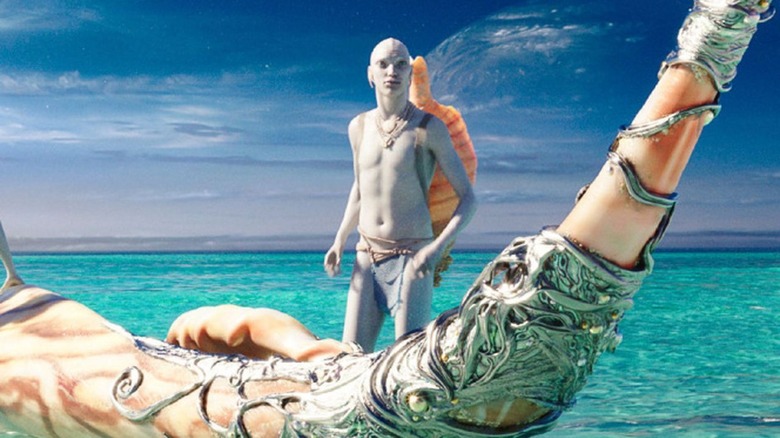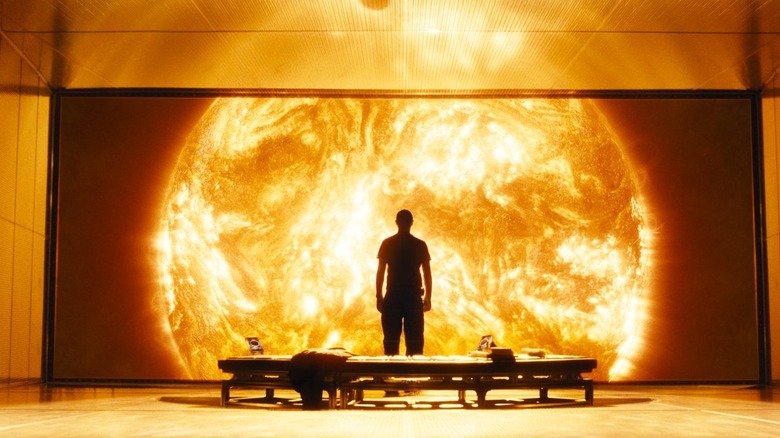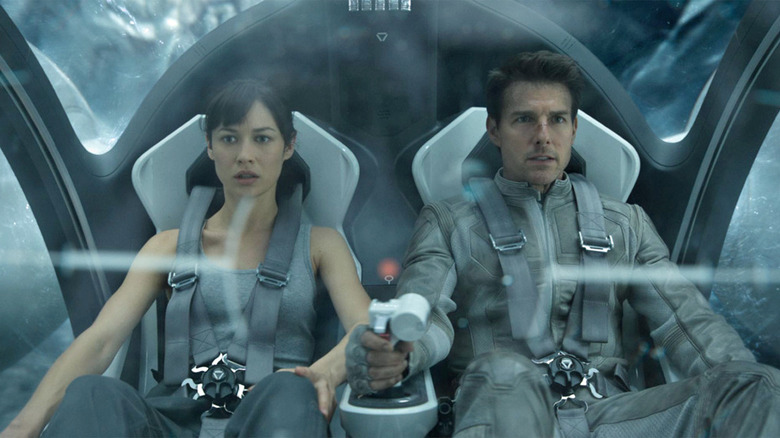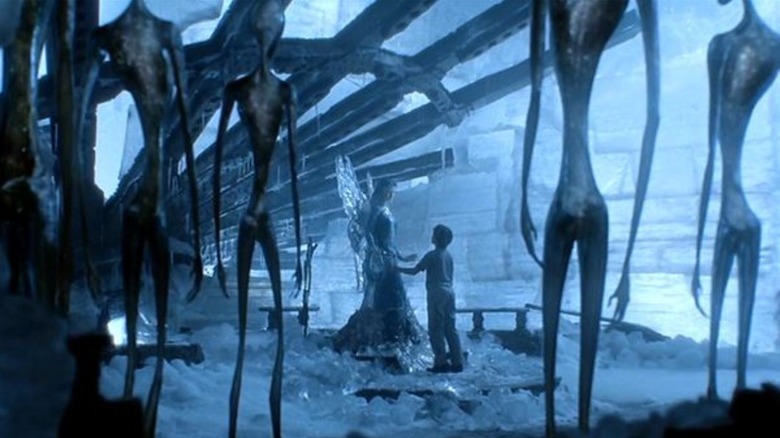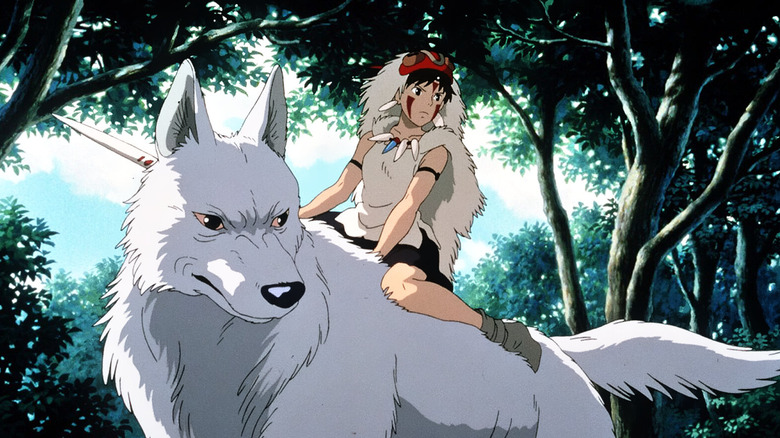12 Stunning Movies Like Avatar: The Way Of Water You Should Watch Next
James Cameron is nothing if not ambitious. His films — from "The Terminator" to "Titanic" — keep getting bigger, better looking, and more inventive. That's true even within his own franchises. "Avatar" stunned the world with its hyperreal yet otherworldly visuals when it premiered in 2009, and earned $2.9 billion dollars at the box office and 9 Oscar nominations in the process. That movie, with its $237 million budget, helped the emerging art of performance motion capture take a giant leap forward with technologies that were invented or improved to bring the Na'vi to life. The massive success of "Avatar" enabled Cameron to plan and produce four more sequels, the first of which is 2002's "Avatar: The Way of Water."
"Avatar: The Way of Water" surpasses the original in terms of budget, runtime, and scope. Its costs ballooned, and the film clocks in at 3 hours and 12 minutes. That's because this time, the world of Pandora has expanded beyond those already captivating bioluminescent rainforests into what Cameron calls "other regions" of the lush, verdant moon, most notably its oceans. That Jake and Neytiri have grown their family and come into contact with new clans also meant the cast had to grow to include characters like Neteyam, Lo'ak, Tuk, and Kate Winslet's Ronal. "Avatar: The Way of Water" might be the most epic, fantastical, and visually stunning movie ever made — at least, until "Avatar 3" drops in 2024. In the meantime, while we're all waiting for our next trip to Pandora, check out these 12 films with similar ambitions, aesthetics, and themes.
Black Panther: Wakanda Forever
It's entirely coincidental that there are two spectacle-laden mega blockbusters this year that feature underwater colonies of bluish humanoids who ride around on giant sea creatures. "Black Panther: Wakanda Forever" doesn't spend as much time in the sea as the "Avatar" sequel, and its version of a civilization that's evolved and adapted to become aquatic hews closer to realism since the fictional (but historically and culturally inspired) Talokan exists under the surface here on Earth. Talokan is beautiful in its own right because of that realism. Instead of a crystal clear view, we see Namor's home world mostly through Shuri's eyes, from behind the glass of her diving suit's helmet. The water is sometimes foggy, sea plants get in the way, and there's less natural light, which means there's an element of surprise when Talokanian swim up to the Wakandan princess to wave hello. Talokan feels a little slimy and cold, in a good way. But once Namor's city under the comes into focus, it's also pretty majestic.
Narratively, Ryan Coogler and James Cameron are interested in similar themes such as the exploitation of natural resources, the displacement of native peoples, and the role of family. "Black Panther: Wakanda Forever" wrestles with whether Vibranium is a blessing or curse the way "Avatar" does with what the humans dub Unobtanium. Its main plot is the fraught political relationship between Wakanda, Talokan, and the industrial world. And some of its most visually breathtaking scenes are also its most emotionally affecting ones, as Shuri reckons with the loss of those she loves.
Life of Pi
From "Crouching Tiger, Hidden Dragon" to "Brokeback Mountain," Ang Lee's films don't have much in common in terms of subject matter or genre. One thing they do share? They all look phenomenal. Lee doesn't have a signature style; he's able to bring his keen eye for composition to every project, no matter how intimate or expansive. In 2012, he used that skill to bring "Life of Pi" — a bestseller that was thought to be unfilmable — to the big screen. The daring adaptation became his most visually stunning to date, a fact which bore out in its 11 Academy Award nominations (it won four, including best director, best cinematography, and best visual effects).
In novel form, not all that much actually happens in the story about a boy who gets stranded in the middle of the Pacific on a lifeboat with a tiger. But Lee plumbed the depths of his imagination to make Pi Patel's internal monologue into a sweeping, supernatural tale of faith and perseverance. Like the "Avatar" films, some of the standout moments in "The Life of Pi" involve bioluminescence, whales, and wide shots of gorgeous but dangerous islands and oceans. To simulate Pi's harrowing journey, Lee used a combination of enormous water tanks and CGI. The same technique was used by Cameron in "Avatar: The Way of Water." "Life of Pi" is frequently cited alongside "Avatar" as making the best use of the medium of 3D. Though the former is considerably more meditative than the latter, it's still an unforgettable sensory experience.
Dune
It's rare for a sci-fi or fantasy blockbuster to make much of an impact on the awards race. "Avatar" was both a critical and commercial success, and its sequel has earned strong reviews and is already showing up on nominations lists. The most recent film to accomplish such a feat was 2021's "Dune," the third adaptation of Frank Herbert's 1965 novel (or at least the first half of it; a sequel is coming next year). Besides the switcheroo that the royal family has to leave their watery world for a dessert a planet, the two franchises share a lot of creative DNA. Both take place off-Earth in the future ("Dune" in a much more distant, dystopian future). Both revolve around the harvesting of resources at great cost to the indigenous people. Both involve killer creatures and weapons technology. And both look amazing. "Dune" also took home trophies for its groundbreaking cinematography and visual effects.
In "Dune," Timothée Chalamet plays Paul Atreides, the son of a Duke sent to rule over Arrakis, an arid planet that contains the galaxy's supply of "spice," a psychotropic drug which can also be used as a fuel. The Atreides have to tread carefully as there's corruption and ill intent with the galactic aristocracy, as well as a tribe of natives called the Fremen who know the dessert and excel at combat. Though he doesn't have humble origins, Paul isn't entirely dissimilar from Jake Sully in that he has his mind expands and he leaves his own people to become a leader among the Fremen. Denis Villeneuve's "Dune" noticeably bleaker than the "Avatar" films, but it's no less astonishing.
Luca
There's a fine line between animation and motion capture, but both require a director's vision and a crew's expertise and commitment. Pixar's "Luca" isn't trying to make its sea monsters look as lifelike as James Cameron's Na'vi. Their adorableness is the point. But "Luca" isn't just cute. Its rendering of the Italian Riviera, bathed in light with sunbaked hillside houses and cobblestones, is some of the most unique-looking animation Disney or Pixar has ever done. The criminally under-seen "Luca" (it skipped theaters and premiered on Disney+ during the pandemic, to little fanfare) would make a great double feature with "Avatar: The Way of Water," especially for families with young kids who suddenly want to be able to turn colors and sprout gills.
The titular Luca is a tween sea monster whose parents forbid him to venture onto the surface world a la King Triton. He befriends an orphaned sea monster named Alfredo and discovers that once he walks on land, he transforms into a human. This trait applies to his entire species, so Luca and Alfredo begin living a double life and getting into trouble in the nearby port town as human boys. They learn about human culture, from Vespas to pasta eating contests, but the threat of being found out — especially by their new friend Giulia's fisherman father — is constantly looming over their heads. "Luca" isn't as serious or metaphorical as the "Avatar" films, but it uses the same conceit in which its main character switches into another body for what becomes, in the end, an emotionally resonant purpose.
The Green Knight
David Lowery's 2021 film "The Green Knight," which is based on the medieval epic poem "Sir Gawain and the Green Knight," is strange and literary, even by independent movie standards. At first glance, it might not seem to overlap much with Cameron's "Avatar" films. "The Green Knight" was made on a shoestring budget of about $15 million using mostly practical effects and relied on CGI only when necessary to add detail to backdrops or size up its giants. Its meandering story is surprisingly devoid of action, despite its violent premise. But those who can stick with this old English allegory to the end (and enjoy the trippy ride along the way) will be handsomely rewarded. The cinematography and production design of "The Green Knight" are whimsical and breathtaking, far beyond what that budget suggests, and the unconventional film is buoyed by an incredible lead performance by Dev Patel as Sir Gawain.
Aside from the fully realized, hauntingly beautiful vibe Lowery creates, his take on this more obscure Arthurian legend comes to many of the same conclusions as Cameron's "Avatars." At the outset, Gawain is a disaffected young man who spurns leadership and responsibility. When he's presented with a challenge, he has to decide who he is and what that'll mean for his future. "The Green Knight" has a lot to say about heroics, but it's just as interested in the antagonistic relationship between human beings and nature. As Cameron did with Pandora and the Na'vi, Lowery uses the Green Knight, a fox, and heaps of magical realism to tell a cautionary tale about indifference to the environment.
Waterworld
Not every movie that's as ambitious as "Avatar" or "Avatar: The Way of Water" succeeds, but 1995's "Waterworld" starring Kevin Costner has gotten a particularly unfair rap. The post-apocalyptic action adventure epic was the most expensive film ever made at the time and famously failed to recoup its budget. However, it wasn't all as bad as its reputation would suggest. "Waterworld" premiered to mixed-negative, not terrible, reviews that noted the inventiveness of the world-building and saved most of their criticism for the performances. The film did decent business at the box office and eventually became profitable thanks to home video. Its eco-conscious concept might have been ahead of its time in the mid-90s, but "Waterworld" has developed a fan following in the decades since, and it's reasonable to think this flawed-but-pioneering project paved the way for movies like "Avatar: The Way of Water" and others on this list.
Set 500 years in the future, "Waterworld" depicts a planet that's almost entirely submerged and uninhabitable after the melting of the polar ice caps dramatically raised sea levels. The very idea of continents with easy access to resources has been relegated to myth. Costner plays "the Mariner," a dirt trader and mutant who's evolved to have gills behind his ears. He comes to the rescue of a girl named Enola who's got a map tattooed on her back that supposedly leads to land. The Mariner, Elona, and her caretaker Helen (Jeanne Tripplehorn) go on the run from the "Smokers," a band of fuel-guzzling pirates led by Dennis Hopper. "Waterworld" might be over-the-top and borderline cheesy, but its mutant sharks and marine-steampunk atolls — not to mention its mostly shot-on-location environments — are worth revisiting.
The Lord of the Rings Trilogy
One of the few epic fantasy or sci-fi franchises that has lived up to and arguably surpassed the legacy of "Avatar" is Peter Jackson's "The Lord of the Rings" trilogy. No single installment sold quite so many tickets as "Avatar" (in fact, the box office totals of all three roughly equal it), but it accomplished some things that "Avatar" couldn't. The final film, "The Lord of the Rings: The Return of the King" was nominated for 11 Academy Awards — including best picture, director, art direction, and visual effects — and it won them all. This widely beloved adaptation of Tolkien's work has become a modern-day classic that many fans revisit year after year, and has woven itself into the fabric of fandom and pop culture to an extent that most intellectual properties (including "Avatar") can only dream about.
The two franchises don't resemble each other much in terms of their respective aesthetics or specific plot points. In keeping with Tolkien's inspirations, Jackson's Middle-earth looks vaguely medieval with Norse, Celtic, and Germanic flourishes and is populated with familiar character archetypes from fairy tales. By contrast, Cameron's Pandora is futuristic and impressively original, inspired by the writer-director's fascination with flora and fauna. But again, both use storytelling on the largest possible scale to deliver parables about proper stewardship of the environment and, more broadly speaking, power. Like Cameron, Tolkien had strong feelings about military and industrial overreach that found their way into Frodo and the Fellowship's quest to destroy the ring and save the world.
Valerian and the City of a Thousand Planets
"Avatar" directly influenced Luc Besson's 2017 film, "Valerian and the City of a Thousand Planets." The director of "The Fifth Element" had been wanting to make a film version of the French sci-fi comic, "Valerian and Laureline," which tells the story of an international station in deep space that becomes home to millions of alien species throughout the universe. He didn't think the technology existed to translate so many different types of humanoids to the screen... until he saw the Na'vi. Besson re-imagined what was possible, rewrote the script, and "Valerian" became the most expensive European and independent movie ever made, with a budget of $180 million dollars.
There are echoes of "Avatar" (and similarities to "Avatar: The Way of Water") to be found throughout "Valerian." Humans take it upon themselves to police the intergalactically intermixed populations. One of them, Major Valerian (Dane DeHaan), begins to have visions about the destruction of a utopian planet and its beings. The Pearls (not unlike the Na'vi) live in harmony with their natural surroundings and have to defend themselves against ruin and hostility from supposedly more civilized and advanced people. With the help of his partner and potential love interest, Sargent Laureline (Cara Delevingne), Valerian gets to the bottom of a conspiracy that has to do with war crimes and energy sources. "Valerian" doesn't reach the level of accomplishment of an "Avatar" film; reviews were mixed-negative, but critics praised its extravagant and idiosyncratic visuals, especially when seen in 3D.
Sunshine
2007's "Sunshine" has an interesting pedigree. Its director, Danny Boyle, is the man behind hits like "Trainspotting," 28 Days Later," and "Slumdog Millionaire." Its screenplay was written by Alex Garland, who penned the script for "28 Days Later," as well as "Ex Machina" and "Annihilation," both of which he also directed. In the vein of James Cameron, Boyle and Garland are filmmakers who play around in the creative sandboxes of sci-fi and horror, but use the genres to explore heady themes such as humanity's unfortunate tendency to be its own worst enemy. "Sunshine" begins with something similar to the human race's motivation in "Avatar," but it goes to much darker and bleaker places from there.
The year is 2057 (what was 50 years in the future at the film's time of release now doesn't seem so far off), and our sun is flaming out, which would necessarily result in an apocalypse that would mean the end of all known life. Eight astronauts are chosen to pilot a ship called Icarus II (a little on the nose) to try and jumpstart our closest star using nuclear fission. A previous team in a vessel dubbed Icarus I tried and failed and never made it back. "Sunshine" isn't as wondrous or, frankly, fun as the "Avatar" films, but this highly underrated sci-fi thriller boasts a terrific ensemble cast that includes Chris Evans (who was up for the role of Jake Sully at the time), Cillian Murphy, Rose Byrne, Benedict Wong, and Michelle Yeoh. And with his relatively low budget, Boyle creates a distinctive look for "Sunshine" that some critics compared to Stanley Kubrick's "2001: A Space Odyssey."
Oblivion
Before Tom Cruise teamed up with Joseph Kosinski to make what will surely end up being the other biggest movie of 2022 ("Top Gun: Maverick"), they collaborated on this post-apocalyptic sci-fi adventure, based on a graphic novel that Kosinski himself wrote and illustrated but never published. The premise of 2013's "Oblivion" is a trope unto itself, but it's a vitally important one, which is why it pops up in futuristic science fiction again and again. It's 2077, and after a war against an aggressive, scavenging species of aliens resulted in nuclear holocaust, the surviving humans have fled the planet for a distant lunar colony. Two specialists who've had their memories wiped, Jack (Cruise) and Victoria (Andrea Riseborough) linger behind on a mission to repair defense drones before it's their turn to depart.
"Oblivion" begins as a tense but entertaining tour of stadium ruins and an abandoned New York City. It's sort of like "Wall-E" if it was a straight-faced, in live-action, and the robots were attractive movie stars. But it transitions into a story that contains a number of parallels to Cameron's work. Again, the military is involved, as are top scientists and fusion energy. And again, our heroes have to rethink their mission once they become embedded with who they thought was the enemy. Oblivion was neither a hit nor a complete failure, but reviews describe its visuals as "mesmerizing" and "absolutely gorgeous." Cruise was also singled out for his strong performance.
AI
The tier of household name, Oscar-winning directors to which James Cameron belongs is pretty exclusive. One of the few other people who can claim to have reached Cameron's degree of mastery in his field is Steven Spielberg. Both Cameron and Spielberg were fans of the late legendary Stanley Kubrick. Cameron, who got a chance to meet Kubrick shortly before his death, saw "2001: A Space Odyssey" early on and was driven to want to innovate in the film industry because of it. Spielberg did Cameron one better and took over production of Kubrick's stalled project, "A.I. Artificial Intelligence," which never got off the ground as Kubrick never had the technology to make his protagonist, David, a real boy.
The film, based on a short story called "Super-Toys Last All Summer Long," is also a loose adaptation of "Pinocchio." And Spielberg didn't end up needing CGI for David (at least not much). He had Haley Joel Osment. Osment's David is an adorable prototype of a sentient robotic boy, programmed to love, joins a family as a coping mechanism after the couple's unwell human son is placed in a medical coma and isn't expected to recover. Once again, "A.I." takes place in a near-ish future in which global warming has risen sea levels, disrupted society, and made much of the world uninhabitable or politically unstable. David, who's effectively immortal, goes from domestic bliss to traumatizing dystopia to a distant future without humans, all without aging a day. Spielberg's take on Kubrick's long-simmering idea wasn't particularly well-received when it premiered in 2001, but in the decades since, it's undergone a public reassessment and in some circles is now considered a masterpiece.
Princess Mononoke
Much has been made about how "Avatar" mirrors films like "Dances with Wolves" and "Fern Gully: The Last Rainforest." But there's one film that Cameron openly admits he homages with his "Avatar" films: Hayao Miyazaki's 1997's animated classic, "Princess Mononoke." The famed Japanese filmmaker came up with many of the plot points and settings that Cameron uses his for his Pandora stories, only years before. In "Princess Mononoke," a cursed prince named Ashitaka must travel to find a cure for his predicament. He meets San (Princess Mononoke), a warrior woman who's one with the plants and the animals, and eventually he joins her battle to stop humans from deforesting her spirit-filled, woodsy home for resources. Ashitaka's true fate isn't a curse but the chance to see the world with "eyes unclouded by hate" and open to the destruction that humans can cause.
"Princess Mononoke" drew acclaim from critics and audiences around the world, who applauded its painterly animation, engrossing action sequences, and mature point of view. If you finish "Princess Mononoke" and are looking for another "Avatar"-like recommendation, though, Miyazaki's 1986's "Castle in the Sky" may have also inspired Pandora's floating islands.
